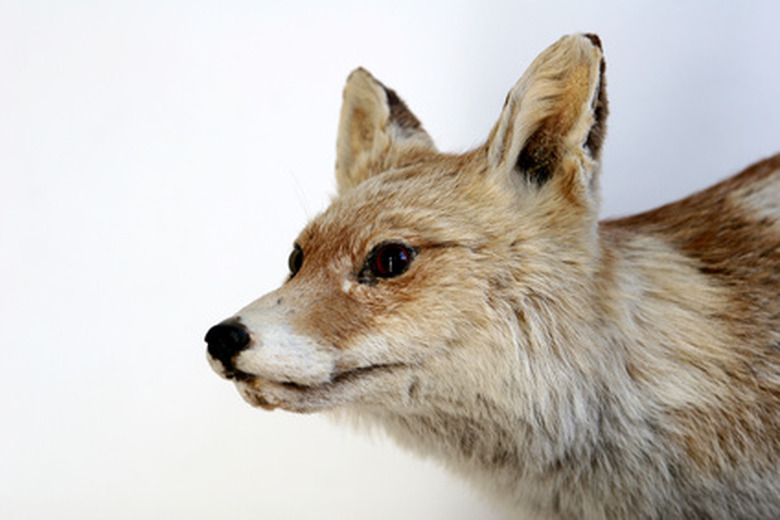Animals That Are Found In Tennessee Ecosystems
Tennessee ecosystems provide habitats for many bird, insect and turtle species as well as bats, red squirrels, chipmunks, foxes, bobcats, black bears, shrews, jumping mice, night herons, mussels, salamanders, raccoons and frogs. Animals in Tennessee are found in high elevation ecosystems, river ecosystems and cave ecosystems.
Animals in the Smoky Mountains
Animals in the Smoky Mountains
Many mammals live in or travel through the high elevation ecosystems of the southern Appalachian Mountains. Above 4, 400 feet, animals in the Smoky Mountains include red squirrels, eastern chipmunks and spotted skunks.
Bald grassy meadows in the middle of forests and on unforested ridge tops provide habitats for woodland jumping mice, the gray fox and bobcat.
Big brown bats fly at night over the high meadows when the American peregrine falcon, the raven, the red crossbill, the snow bunting and the red-breasted nut hatch have left the skies.
Warblers are common in these high meadows, including the black-throated green warbler, the magnolia warbler, the black-throated blue warbler and the Canada warbler.
Seen only rarely is the elusive Saw-whet owl, which makes its home in these high forests. Several species of shrews, even rarer in other Tennessee ecosystems, are also occasionally found here, including the pygmy shrew, the long-tailed shrew and the masked shrew. They cohabitate this area with unusual amphibians, such as the imitator salamander and the pigmy salamander.
In open areas such as Cataloochee and Cades Cove in the Smoky Mountains, white-tailed deer, raccoon, wild turkeys and woodchucks can be seen, as well as elk and black bears. It is estimated that 1,500 black bears live in the Smoky Mountains National Park.
Wolves in Tennessee
Wolves in Tennessee
Tennessee used to be home to the red wolf, but humans hunted it to extinction in the Southeast United States. The National Parks Service attempted to return the species to the Cades Cove, where it has in the past existed as a predator in the food chain of animals in Tennessee. The pack died out despite human efforts, and currently, there are no known wolves in Tennessee.
Animals in the Big River Ecosystem
Animals in the Big River Ecosystem
The Big River Ecosystem in Tennessee is an aquatic ecosystem that collects water from smaller streams that feed into it. It provides a habitat for creatures such as blue catfish, soft-shell turtles and the majestic osprey, which flies above the cottonwood trees.
Black-crowned night herons, smaller than blue herons, visit the shores of the river at sunrise and sundown. Washboard mussels, which live for 60 years or more and filter the water, frogs and salamanders make their home in this Tennessee river ecosystem.
Since this particular ecosystem also includes the channels of water that flow into the river as well as the floodplain, river basin and tributaries, there are many more animals present here. There are fish, such as the Smallmouth Buffalo, and reptiles in the river that provide food for the night herons, and plankton is an important source of food for other animals.
The smooth soft-shell turtle is accompanied in the river and on its banks by crayfish, insects, snails, worms and larvae of the burrowing mayfly. These mayflies are often eaten by swallows, which patrol the river.
Animal Colonies in Caves
Animal Colonies in Caves
Tennessee has the highest number of known caves in the U.S. The state's 9,600 documented caves make up an ecosystem that contains hundreds of rare and unique animal species.
Gray bats and Indiana bats are two examples of at least 10 species of bats that fly through these caves. They are both on the endangered list, although they do occur in colonies that have populations in the thousands. Hundreds of invertebrates such as beetles, isopods, amphipods, millipedes and snails share the caves with the bats.
Wood rats, flies and cave spiders spend part of their lives in Tennessee's caves, while the Tennessee cave salamander, blind cave fish, the eyeless cave shrimp and cave crayfish spend their entire lives in the caves in the absence of light.
Nine species of crickets found nowhere else also inhabit Tennessee's caves.
Cite This Article
MLA
Juhasz, Francine. "Animals That Are Found In Tennessee Ecosystems" sciencing.com, https://www.sciencing.com/animals-found-tennessee-ecosystems-7316671/. 22 November 2019.
APA
Juhasz, Francine. (2019, November 22). Animals That Are Found In Tennessee Ecosystems. sciencing.com. Retrieved from https://www.sciencing.com/animals-found-tennessee-ecosystems-7316671/
Chicago
Juhasz, Francine. Animals That Are Found In Tennessee Ecosystems last modified August 30, 2022. https://www.sciencing.com/animals-found-tennessee-ecosystems-7316671/
